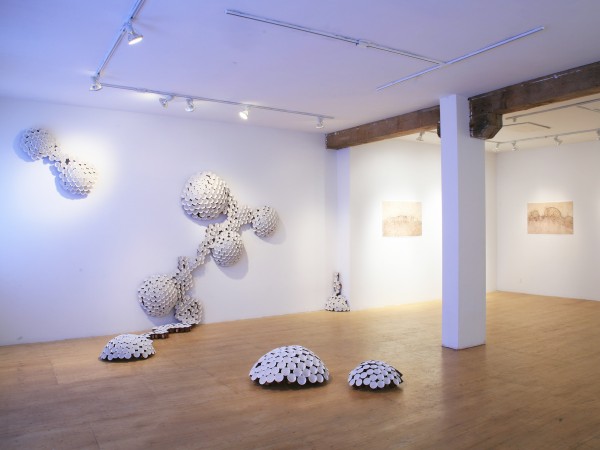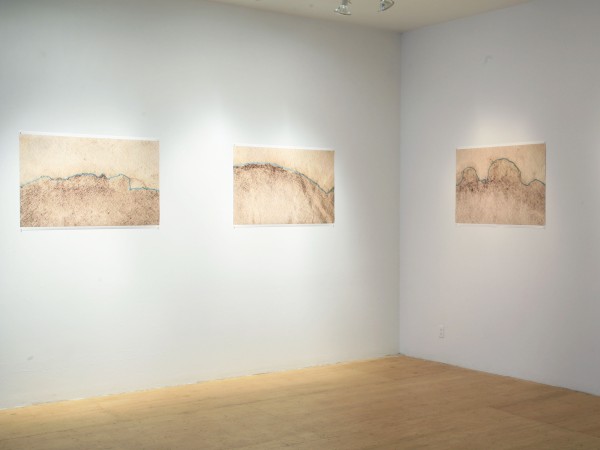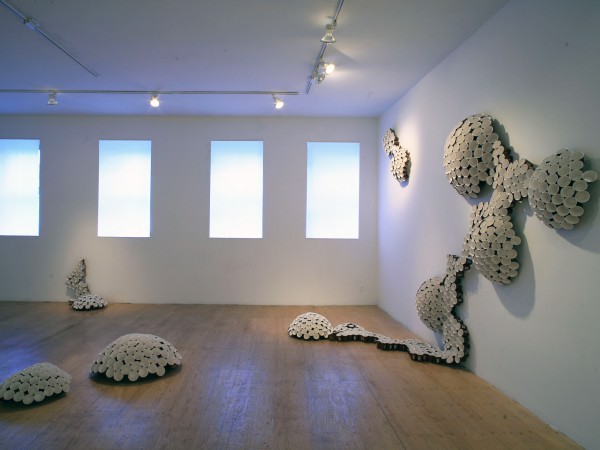Mariana Gullco’s site-specific work, entitled Jetables, featured sculptural, pictorial, functional as well as decorative elements. In the work, Gullco combined a wide range of objects that, as a whole, suggested both vastness and lightness. The artist travelled from Mexico to LA CHAMBRE BLANCHE in order to participate in an artistic exchange inspired, amongst other things, by her experience of integrating into a new milieu and her observation of the domestic and cultural habits of the Quebecois. These observations gave rise to her art works, which she created using everyday materials, such as waxed cardboard containers and coffee filters.
At the far end of the exhibition space, unused white coffee cups were spread out on the floor, in an arrangement that climbed the wall, extending up to the ceiling. The small domes, stuck one to the other, formed a series of seemingly endless piles, creating the feeling of perpetual movement. The form engendered by this assemblage evoked numerous organic shapes: molecules clumped together; moss sprawling in the undergrowth; an avalanche of snowballs; a cloudy sky; glaciers adrift; or pristine summits… The impressive quantity of paper cups conjured up the idea of surplus and disposability.
On another of the walls of the exhibition space, used coffee filters, made of unbleached paper, marked with stains of a slightly darker colored brown, were stitched together in small groups. A very discrete fine line in turquoise, embroidered in thread on each filter, separated the two tones of brown. The finesse of this microscopic trace, added like a signature to each filter, spoke of the high degree of attention to detail that Mariana Gullco brought to the poeticization of the objects in her work. The contrast between the elegance and delicacy of her approach and the raw nature of the waste materials with which she worked instantly gave rise to a feeling of paradox.
The low-relief sculpture of Gullco’s essentially monochrome and organic-like compositions brought to mind the image of a mass a mushrooms clustered on the bark of a tree trunk. In choosing to work with simple artifacts, which bore the trace of their use through her addition of a magnificent swarm of colored fibers, the artist simulated nature as much through her signaling of the plant origins of the material as by her echo of a widespread and daily ritual, the preparing of coffee.
Photographic enlargements of a number of the filters used by the artist were presented on the wall adjacent to the sculpture. These detailed and large-format views recreated the map of imaginary landscapes, tracing the winding movement of a stream through the sands of a desert, or the path of a fissure in an erg.
So it was that the groupings of coffee cups mushrooming like moss in the forest, along with the mass of used filters, whose function was altered and form embellished, gave rise to the physical sensation of being invaded. The mass of disposable objects collected by the artist in the space of only a few days was suffocating as, faced with their abundance, their lightness of form gave way to a weighty feeling. A choking feeling invaded the viewer, echoing the earth’s own breathlessness. The accumulation and piling up of these simple artifacts, derivatives of petroleum, almost inevitably redirected our attention to thoughts of expansion and invasion. Thus, the astonishingly fine blue line, moving amongst the mass of homogenous objects arranged on almost all of the gallery surfaces became a brilliant thread of hope, the sign of an opening, of a clearing. This blue line traced the limits, symbolized the passage of the daily life of the other, the consumer, the coffee drinker. It stood as a sign of humanity, a luminous feature amidst monotony, the expression of subjectivity within the repetition of the series.
Through her use of needlework, Mariana Gullco combined the methods of the artist and artisan, emphasizing the value and potential of mixity on all levels. By uniting different approaches, and integrating industrial materials into aesthetic wholes, she heightened, transformed and returned a sense of pleasure to the standard decorative motifs used in commercial products. Thus, at the entrance to LA CHAMBRE BLANCHE’s exhibition space, the artist had fixed four white plastic support structures. On each, she placed a roll of paper towel, bearing floral and maritime motifs embroidered by the artist, revealing another highly refined and elaborate aspect of her practice. The same blue thread used on the coffee filters appeared in the stitching of minute spiral and flower-like forms, superimposed on the decorative print produced by the paper’s manufacturer, adding subtle bursts of color.
It is not unusual to find textile materials in the studio of an artist. However, the specificity of Mariana Gullco’s work likes in the astonishing way in which she recuperates forms of paper disposed of so readily everyday, rendering them unique through her addition of decoration. Through this metamorphosis, they become rare. She creates a permanent tension, a game of ongoing slippage, between the common and the precious, the ordinary and the fantastic, the essential and the futile.
Like many artisans, Gullco’s approach to using materials seems to emphasize know-how, related to means of fabrication. Her work evokes popular art forms in Mexico and shows the influence of a long tradition of indigenous craft, which has nowadays been appropriated by the tourist market and industry. For her previous exhibition, the artist worked with used sachets of medicinal herbs and tea leaves, collecting them in their thousands with the help of friends and family. She used them to create new functional objects, including an immense cover, once again employing craft-based techniques such as sewing. In another work inspired by the Taoist concept of yin and yang, the artist turned to crochet.
Mariana Gullco’s ‘jetables’ (disposables) re-actualize techniques that are rooted in centuries of customs of the peoples of tropical America. She transforms waste materials into souvenirs and relics, whether by presenting the objects in their original form, which enables the public to immediately recognize them, or by embellishing them. Faced with these common objects that form an almost living universe, the artist invites us to see, to grasp things differently, drawing our attention to notions such as the minute and the infinite. The approach involved in looking at the works constructed by Gullco is not strictly intellectual, rather it is physical and conscious in a relationship that reminds us of the incredible force of attraction and interdependence that exists between the individual and matter.
This Mexican artist often involves those around her in the devising of her exhibitions, inviting them to participate in the creative process, notably by collecting everyday items, and then giving them a second breath of life. Her very real interest in humanity is there for all to see. The waste materials that she uses bear in them a sense of the universal; they test the sense of humanity in each of us. Whilst her works may not always arouse debate, they prompt the viewer to reconsider the notions of responsibility and freedom, and to reexamine their relationship with the material world and daily life. Gullco’s art opens a space in which to reflect on infinity, on man’s presence in space, on what Alain Cotta referred to as “our intentionality with regard to the world.” By restoring the poetic force of objects, her work inevitably confronts us with the problem of the erosion of the beauty of the world.
What is remarkable in the work of Mariana Gullco is its dazzling sense of integrity and immanent human sensitivity. In choosing to work with everyday materials, and reappropriating the ceremonial nature of needlework, Gullco has created her own language, a “language with which to speak directly to the viewer,” as the artist describes it. Her concerns drive her creative practice, and a sense of urgency that is inseparable from the importance of “doing”. An encounter with Mariana Gullco is perhaps a moment in which to recall one’s own passage in the universe, which is marked by the traces that one leaves, traces that proliferate. Art works, along with the world and conscience itself, are always a matter of remaking.


